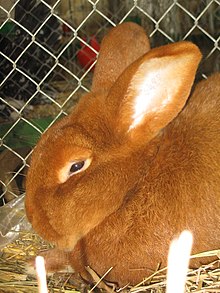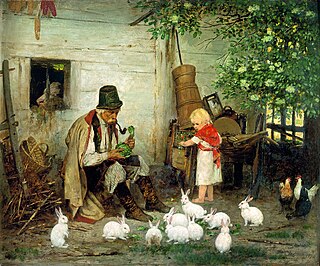
Cuniculture is the agricultural practice of breeding and raising domestic rabbits as livestock for their meat, fur, or wool. Cuniculture is also employed by rabbit fanciers and hobbyists in the development and betterment of rabbit breeds and the exhibition of those efforts. Scientists practice cuniculture in the use and management of rabbits as model organisms in research. Cuniculture has been practiced all over the world since at least the 5th century.

The Angora rabbit, one of the most ancient groups of domestic rabbit breeds, which is bred for the long fibers of its coat, known as Angora wool. They are gathered by shearing, combing or plucking. Because rabbits do not possess the same allergy-causing qualities as many other animals, their wool is an important alternative. There are at least 11 distinct breeds of Angora rabbit, four of which are currently recognized by the American Rabbit Breeders Association (ARBA): the English Angora, the French Angora, the Giant Angora and the Satin Angora. Other unrecognized breeds include the German Angora, the Finnish Angora, the Chinese Angora, the Japanese Angora, the Korean Angora, the Russian Angora, the St Lucian Angora and the Swiss Angora.

The Netherland Dwarf is a breed of domestic rabbit that originated in the Netherlands. Weighing 1.1–2.5 pounds (0.50–1.13 kg), the Netherland Dwarf is one of the smallest rabbit breeds. Its popularity as a pet or show rabbit may stem from its neotenic appearance. The Netherland Dwarf is recognised by both the American Rabbit Breeders Association (ARBA) and the British Rabbit Council (BRC). The Netherland Dwarf is often confused with the Polish breed of rabbit, but the latter has longer ears, a non-brachycephalic head and less cobbiness.
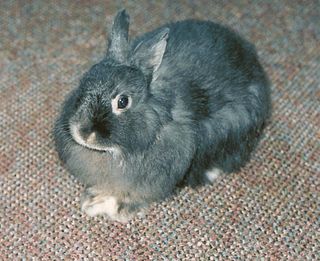
The Jersey Wooly is a breed of domestic rabbit weighing about 3 pounds with a bold head and wool fur on their body.

The Californian, also known as the California White, is a breed of domestic rabbit initially developed for the fur and meat industries by George S. West of Lynwood, California, starting in 1923. West maintained a herd of 300 genetically pure New Zealand Whites, which he began crossing with Standard Chinchilla rabbits for their dense coat and Himalayan rabbits. This new breed, named after the state of its origin, was first shown in 1928, and a standard was accepted by the American Rabbit Breeders Association (ARBA) in 1939.

The Mini Lop is a breed of domestic rabbit that is recognized by the American Rabbit Breeders Association (ARBA). It is different from the Miniature Lop breed that is recognized by the British Rabbit Council (BRC). The Mini Lop [US] and the Miniature Lop [UK] are different from the Dwarf Lop breed that is recognized by the BRC. The Mini Lop is similar to several other small rabbit breeds, such as the Dwarf rabbit.
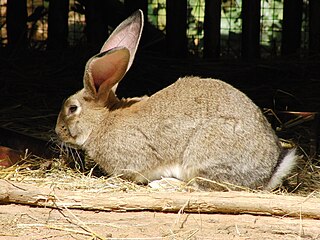
The Flemish Giant rabbit is the largest breed of domestic rabbit. They weigh 6.8 kilograms on average, though the largest ones can weigh up to 22 kilograms. Historically they are a utility breed used for their fur and meat. In the modern day, they are no longer commonly raised for meat, due to their slow growth and very large bones, and are raised for exhibition at rabbit shows. They are often kept as pets as they are known for being docile and patient when being handled.

Lionhead is a breed of domestic rabbit recognized by the British Rabbit Council (BRC) and by the American Rabbit Breeders Association (ARBA). The Lionhead rabbit has a wool mane encircling the head, reminiscent of a male lion as its name implies. Other Lionhead characteristics include a high head mount, compact upright body type, short well-furred 2- to 3+1⁄2-inch ears, and a weight of 2.5 to 3.75 pounds.

The term rex rabbit refers informally to one of at least eight breeds of domestic rabbit. One such breed is the Rex, which is recognized by the American Rabbit Breeders Association (ARBA) and by the British Rabbit Council (BRC). Other modern-day rex rabbit breeds are listed below. Care must be taken to distinguish the rex rabbit breeds from the three types of rex rabbit fur for which they are known.

The American Rabbit is a breed of rabbit, recognized by the American Rabbit Breeders Association (ARBA) in 1917. According to the ARBA Standard of Perfection, American rabbits have a mandolin body shape. It has also been noted for a docile temperament and good mothering abilities. As with all domestic rabbits, the American breed is of the species Oryctolagus cuniculus, the European wild rabbit.

The Argenté rabbit is one of the oldest breeds of French show rabbits. The British Rabbit Council (BRC) recognises six varieties: Argenté Bleu, Argenté Brun, Argenté Crème, Argenté de Champagne, Argenté Noir, and Argenté St Hubert. The American Rabbit Breeders Association (ARBA) recognises the Champagne d'Argent, the Crème d'Argent and the Argenté Brun. A rare variety, the Argenté Clair, is not currently recognised by either the BRC or ARBA.
The Cinnamon rabbit is a breed of domesticated rabbit created "accidentally" in 1962 and named for its coat color. The Cinnamon is currently recognized by the American Rabbit Breeders Association (ARBA) but not by the British Rabbit Council (BRC).

The Silver Fox rabbit is a rare breed of domestic rabbit developed by Walter B. Garland of North Canton, Ohio, and bred for meat, show, and its unique fur. The breed is recognized by the American Rabbit Breeders Association.
The Altex is a commercial breed of domestic rabbit developed, beginning in 1994, for cuniculture, specifically for the rabbit meat industry. The Altex breed is not recognized by the American Rabbit Breeders Association (ARBA) or by the British Rabbit Council (BRC).
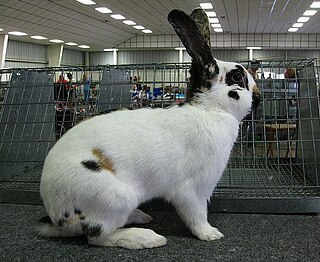
The Rhinelander is a medium-sized breed of domestic rabbit that originated in Germany. Rhinelanders are known for their distinctive facial "butterfly markings", a spine marking, colored ears, cheek spots, eye circles and side markings of black with orange or of blue with fawn. The Rhinelander breed is recognized by the British Rabbit Council (BRC) and by the American Rabbit Breeders Association (ARBA).

The Blanc de Hotot is a medium-sized rabbit breed originally developed in France. It is a compact, thickset white rabbit with spectacle-like black rings around each dark eye. First bred in Hotot-en-Auge, Normandy, France in the early 1900s, the breed spread throughout Europe and into North America by the 1920s. Initially unpopular in the United States, it died out there, and suffered population decline in World War II-era Europe. It began to spread again in the 1960s and 1970s, and was re-imported to the US in 1978. Today it is recognized by the British Rabbit Council and the American Rabbit Breeders Association, but is considered globally endangered, with a listing of "threatened" status by the American Livestock Breeds Conservancy.

The Miniature Lion Lop is a breed of domestic rabbit recognised by the British Rabbit Council. The breed is not currently recognized by the American Rabbit Breeders Association. In addition to its lop ears, the distinguishing feature of this breed is its Lionhead-type mane and its small size: 1.5–1.6 kilograms (3.3–3.5 lb).

The Himalayan rabbit is a small breed of rabbit with similar markings to the Californian rabbit. The body is white with colored points, recognized colors are black, blue, chocolate and lilac.
